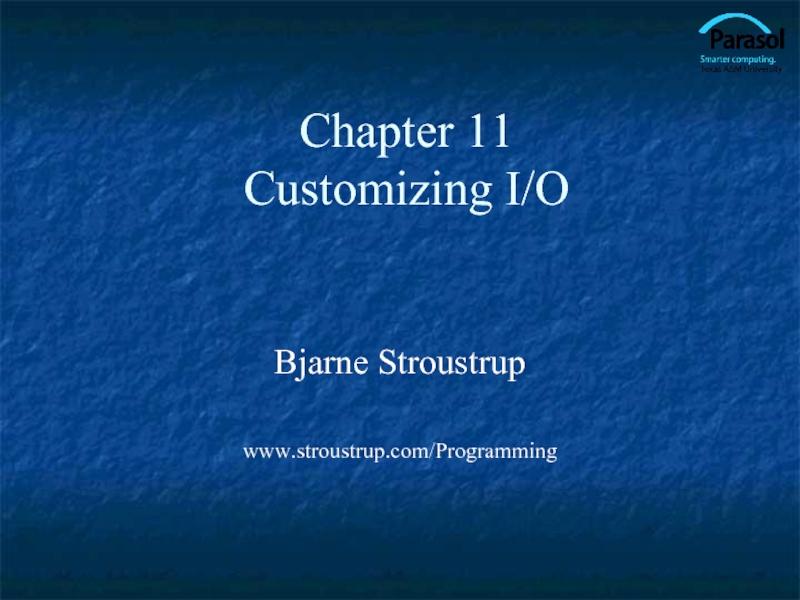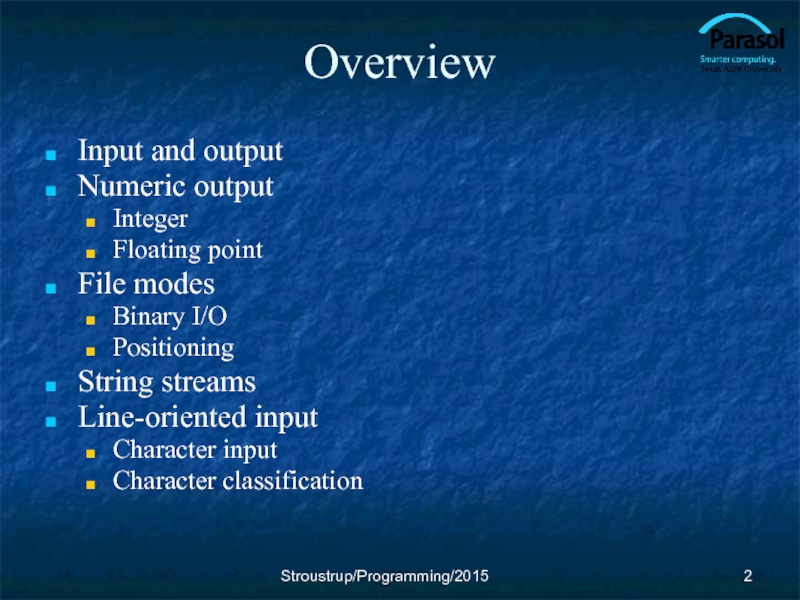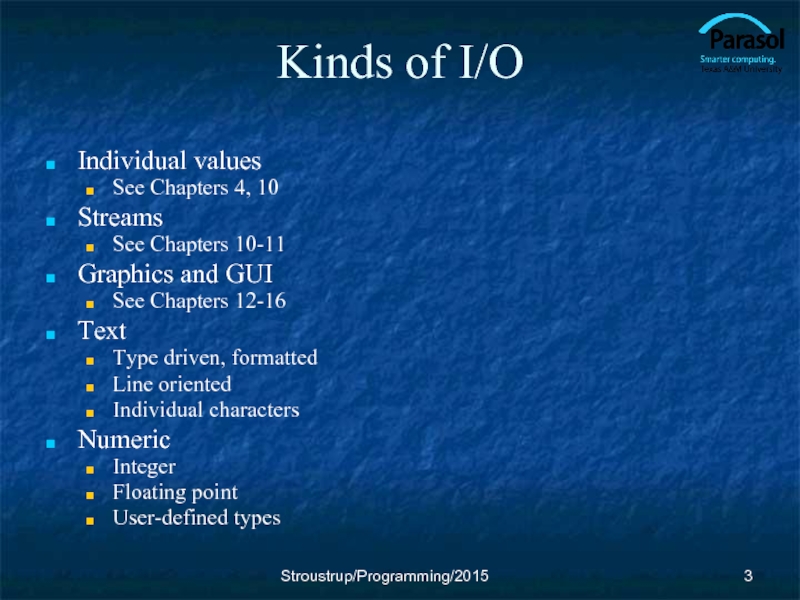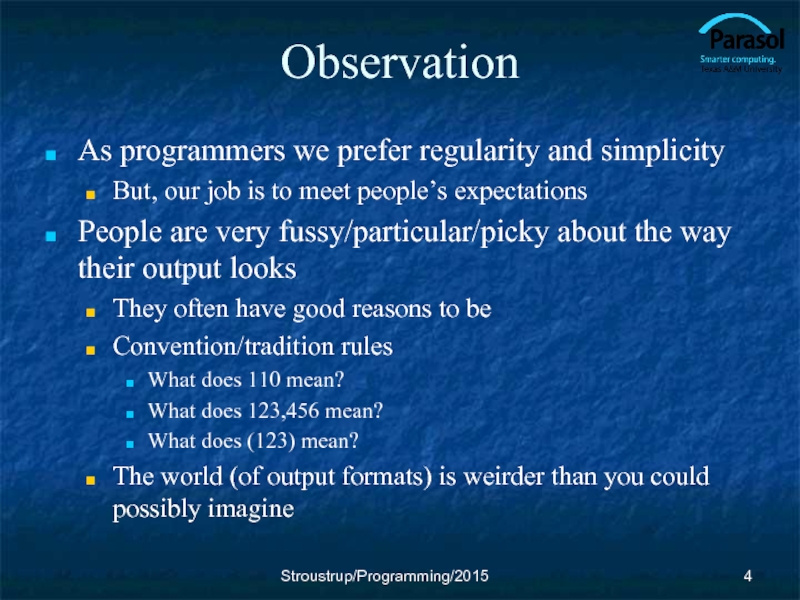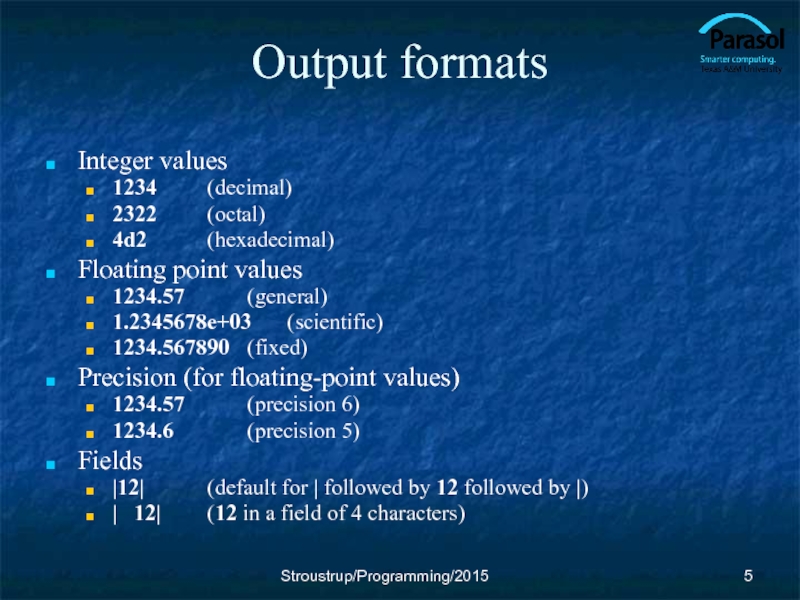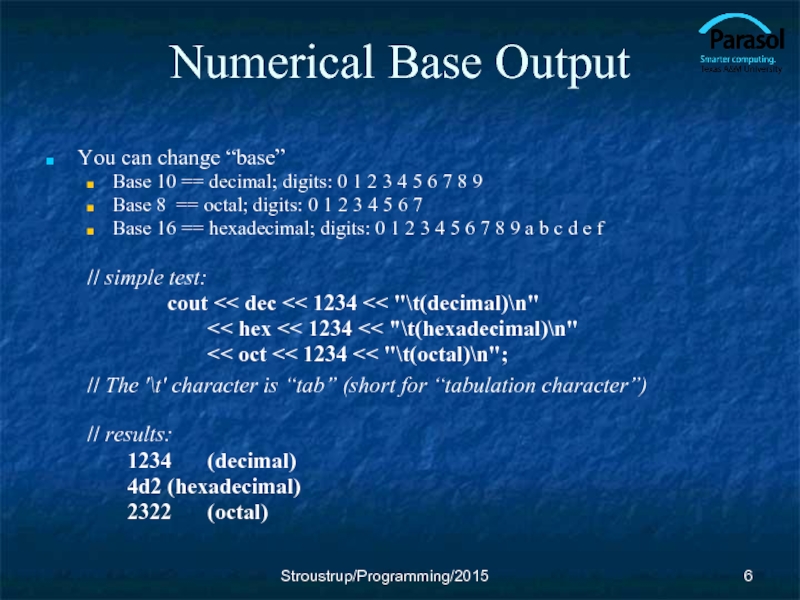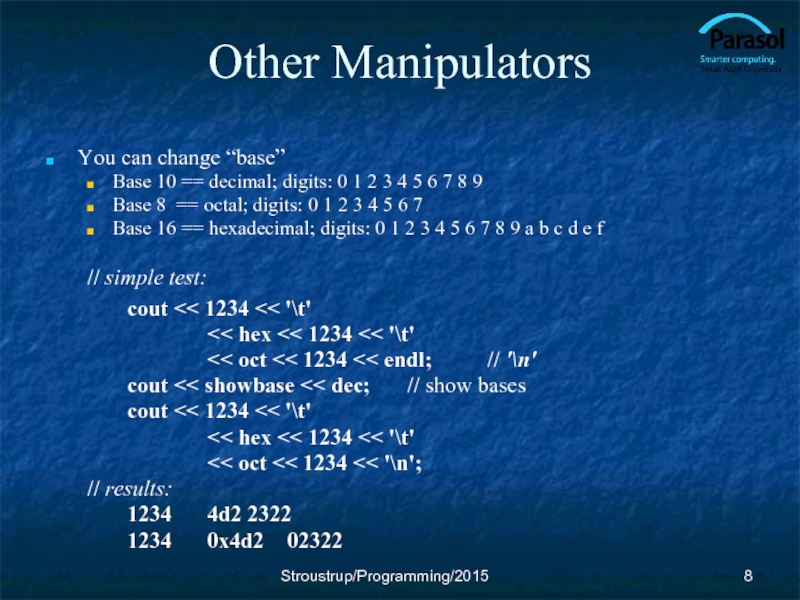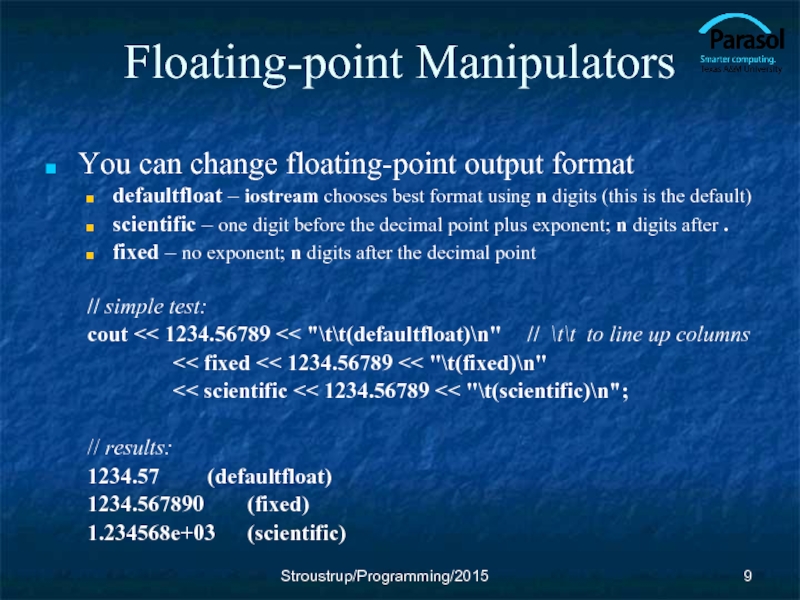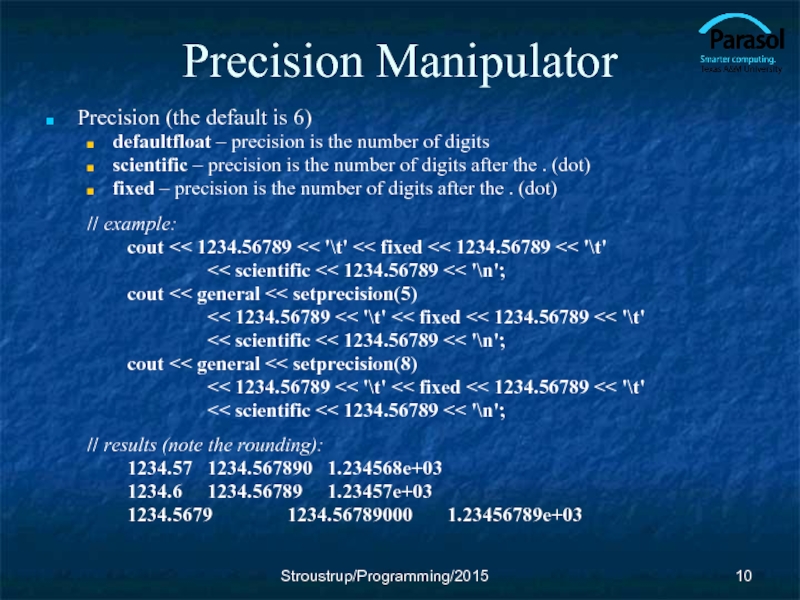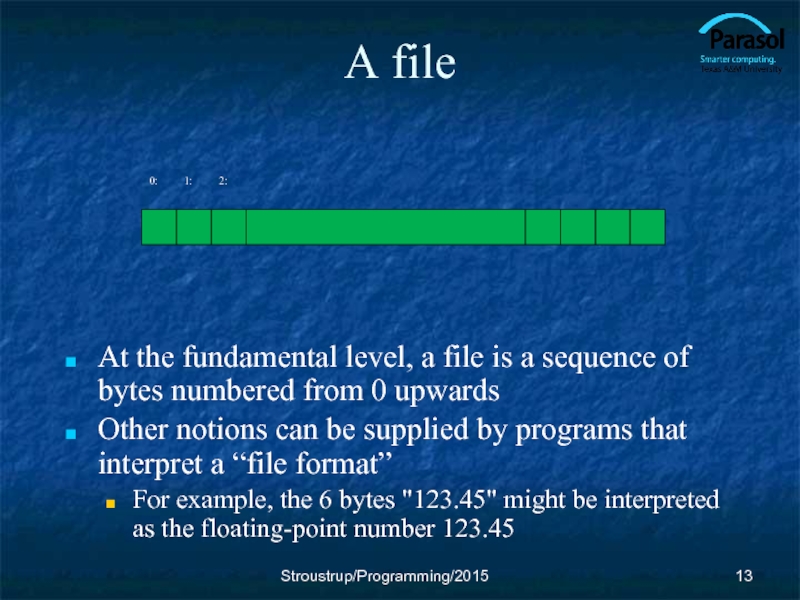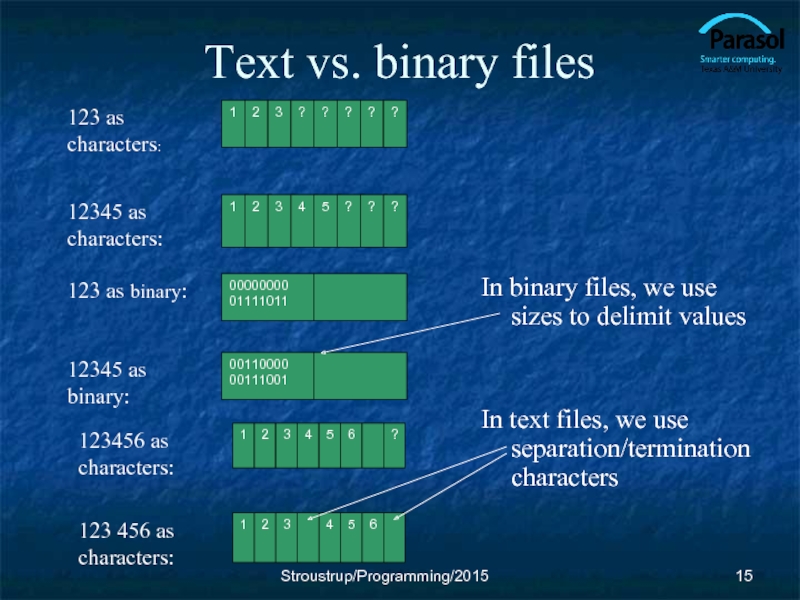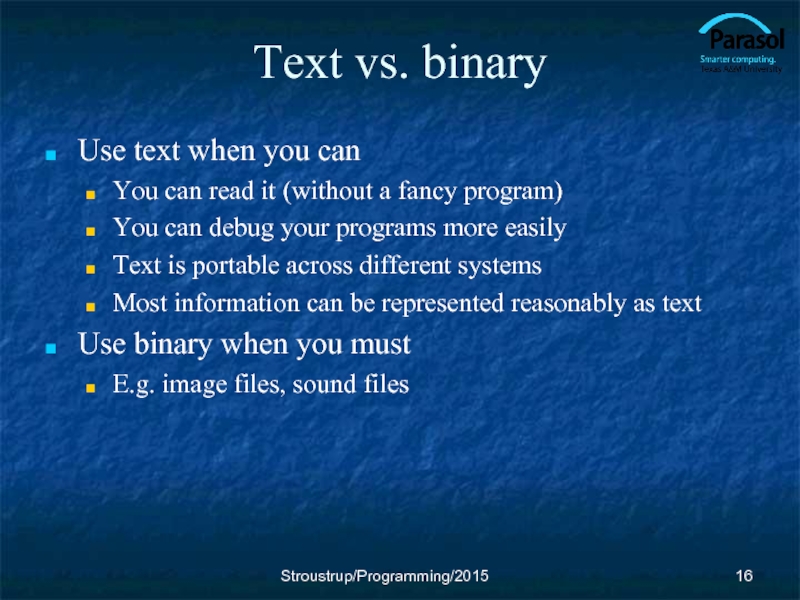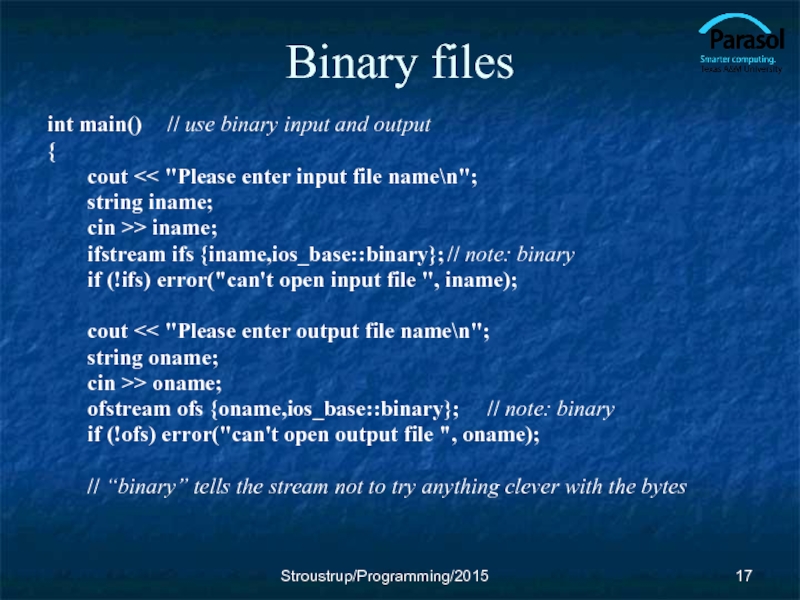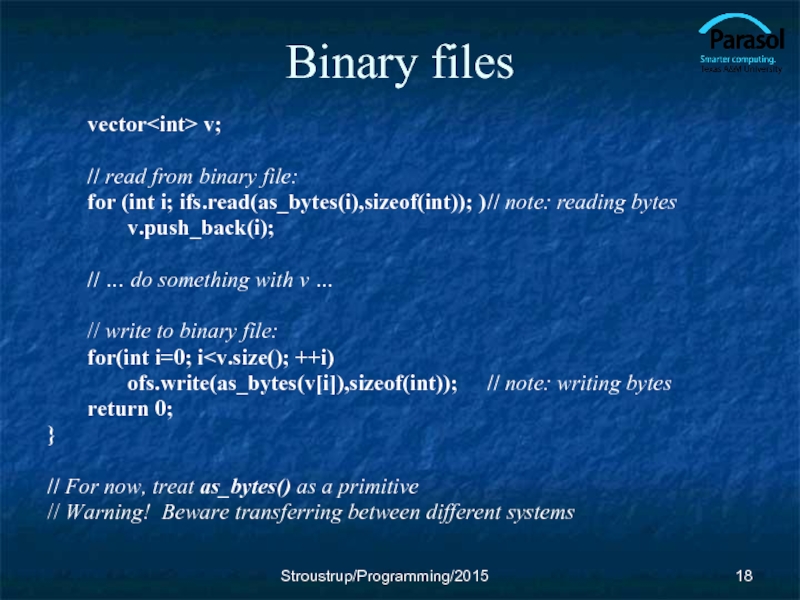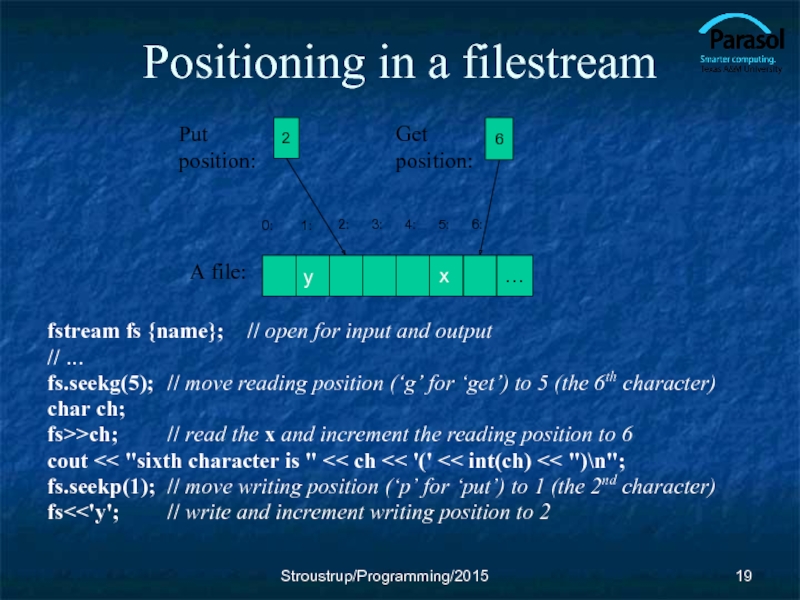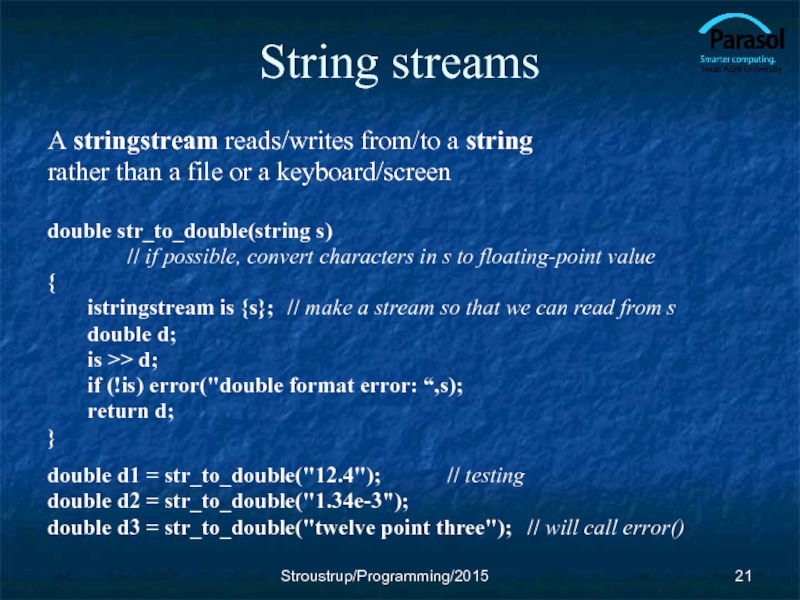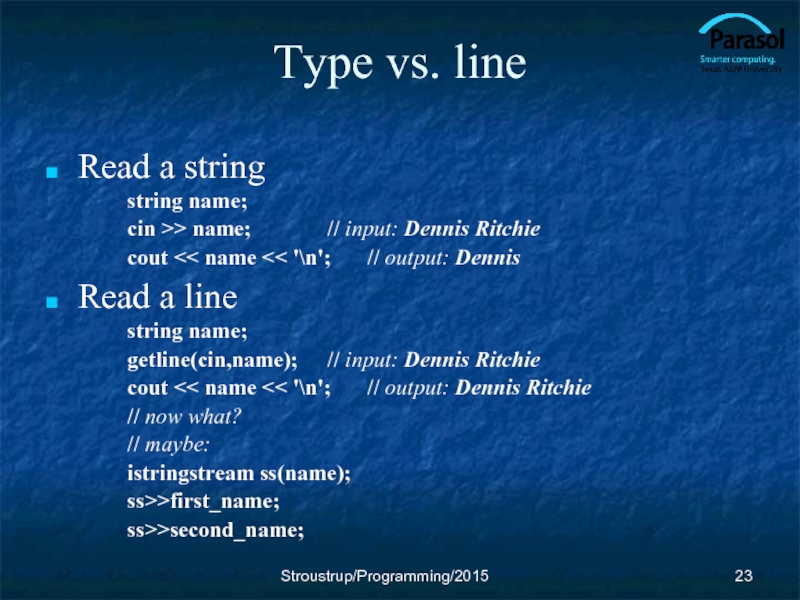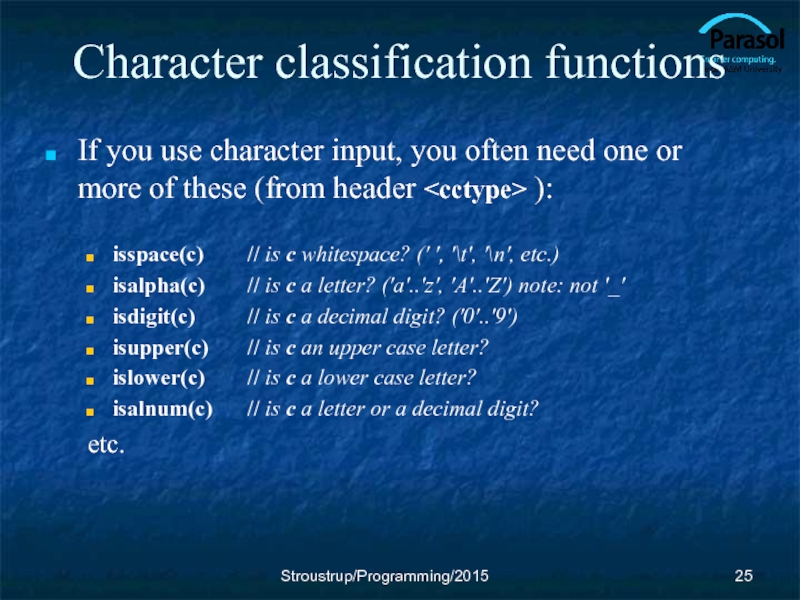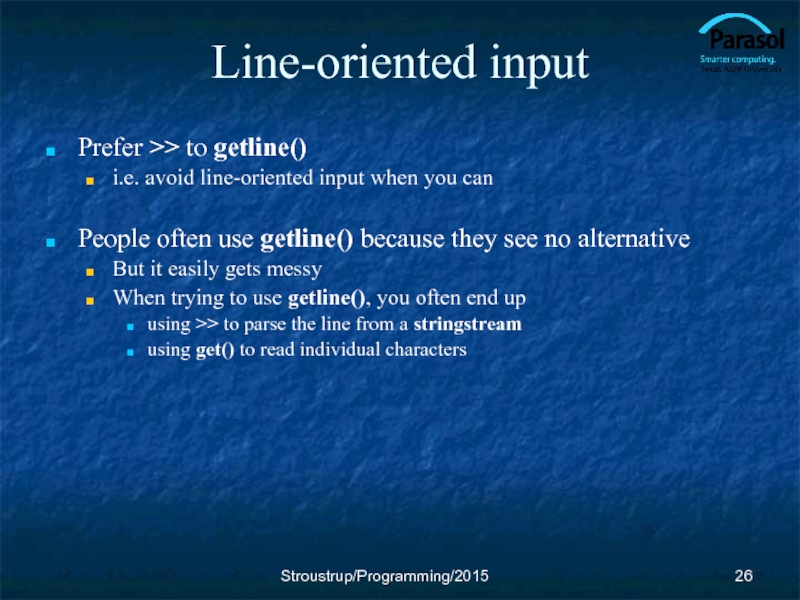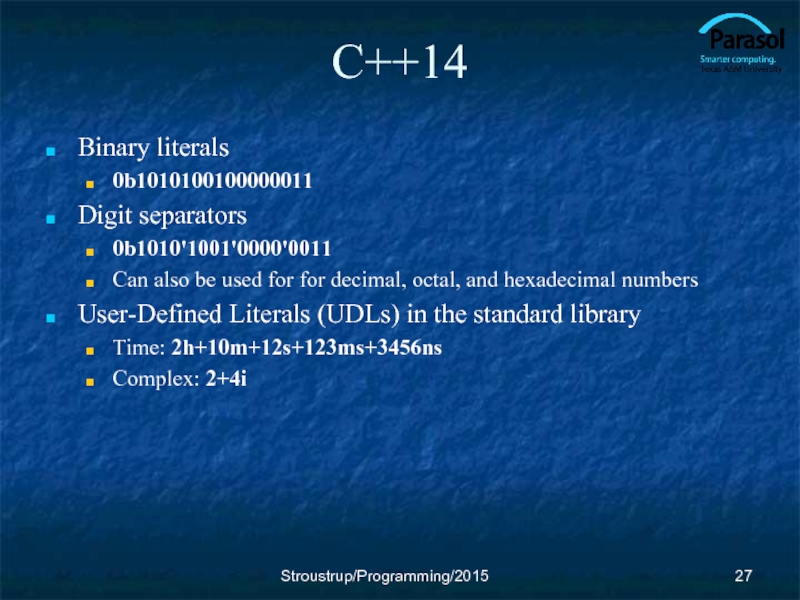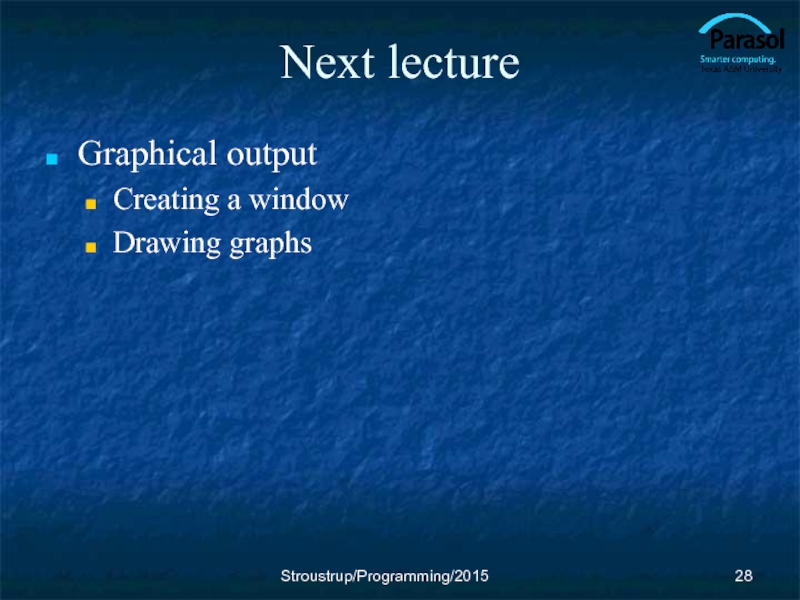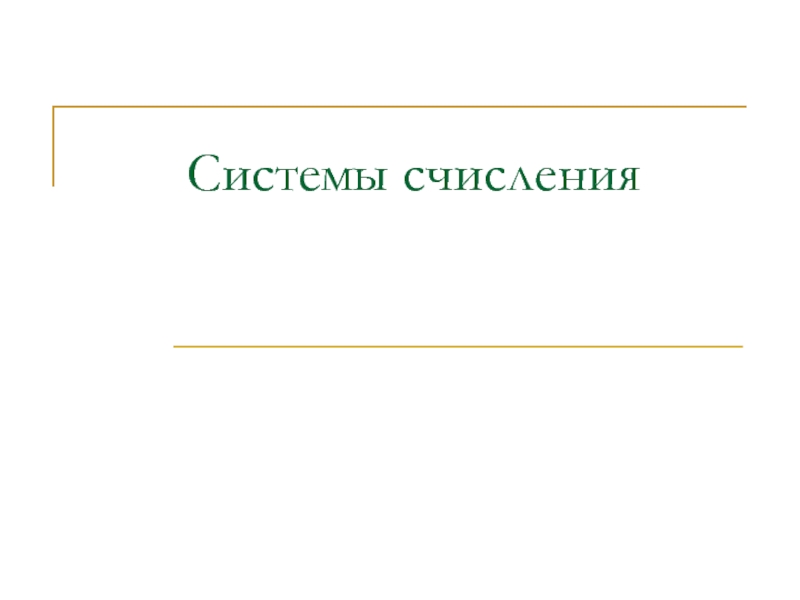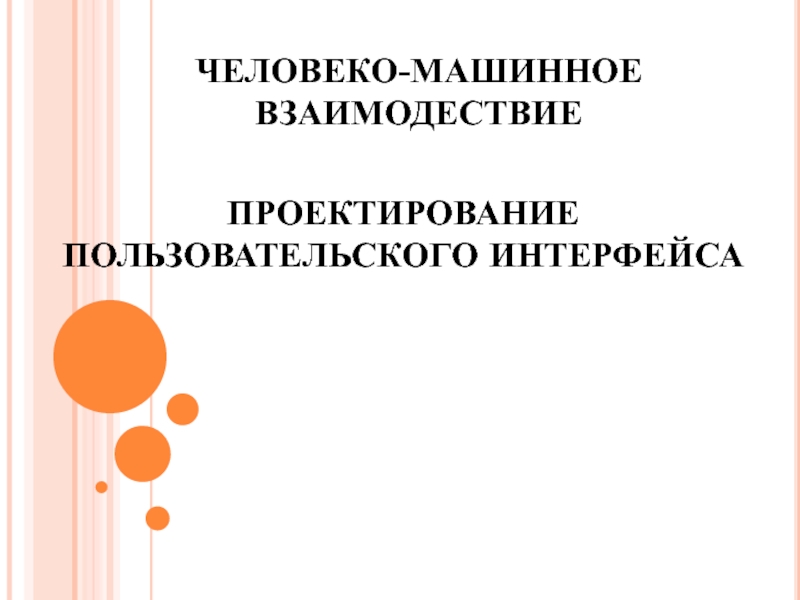- Главная
- Разное
- Дизайн
- Бизнес и предпринимательство
- Аналитика
- Образование
- Развлечения
- Красота и здоровье
- Финансы
- Государство
- Путешествия
- Спорт
- Недвижимость
- Армия
- Графика
- Культурология
- Еда и кулинария
- Лингвистика
- Английский язык
- Астрономия
- Алгебра
- Биология
- География
- Детские презентации
- Информатика
- История
- Литература
- Маркетинг
- Математика
- Медицина
- Менеджмент
- Музыка
- МХК
- Немецкий язык
- ОБЖ
- Обществознание
- Окружающий мир
- Педагогика
- Русский язык
- Технология
- Физика
- Философия
- Химия
- Шаблоны, картинки для презентаций
- Экология
- Экономика
- Юриспруденция
Customizing I/O. (Chapter 11) презентация
Содержание
- 1. Customizing I/O. (Chapter 11)
- 2. Overview Input and output Numeric output Integer
- 3. Kinds of I/O Individual values See Chapters
- 4. Observation As programmers we prefer regularity and
- 5. Output formats Integer values 1234 (decimal) 2322 (octal) 4d2 (hexadecimal)
- 6. Numerical Base Output You can change “base”
- 7. “Sticky” Manipulators You can change “base”
- 8. Other Manipulators You can change “base” Base
- 9. Floating-point Manipulators You can change floating-point output
- 10. Precision Manipulator Precision (the default is 6)
- 11. Output field width A width is the
- 12. Observation This kind of detail is what
- 13. A file At the fundamental level, a
- 14. File open modes By default, an ifstream
- 15. Text vs. binary files In binary files,
- 16. Text vs. binary Use text when you
- 17. Binary files int main() // use binary input
- 18. Binary files vector v; // read
- 19. Positioning in a filestream fstream fs {name}; //
- 20. Positioning Whenever you can Use simple streaming
- 21. String streams A stringstream reads/writes from/to a
- 22. String streams See textbook for ostringstream String
- 23. Type vs. line Read a string string
- 24. Characters You can also read individual characters
- 25. Character classification functions If you use character
- 26. Line-oriented input Prefer >> to getline() i.e.
- 27. C++14 Binary literals 0b1010100100000011 Digit separators 0b1010'1001'0000'0011
- 28. Next lecture Graphical output Creating a window Drawing graphs Stroustrup/Programming/2015
Слайд 2Overview
Input and output
Numeric output
Integer
Floating point
File modes
Binary I/O
Positioning
String streams
Line-oriented input
Character input
Character classification
Stroustrup/Programming/2015
Слайд 3Kinds of I/O
Individual values
See Chapters 4, 10
Streams
See Chapters 10-11
Graphics and GUI
See
Text
Type driven, formatted
Line oriented
Individual characters
Numeric
Integer
Floating point
User-defined types
Stroustrup/Programming/2015
Слайд 4Observation
As programmers we prefer regularity and simplicity
But, our job is to
People are very fussy/particular/picky about the way their output looks
They often have good reasons to be
Convention/tradition rules
What does 110 mean?
What does 123,456 mean?
What does (123) mean?
The world (of output formats) is weirder than you could possibly imagine
Stroustrup/Programming/2015
Слайд 5Output formats
Integer values
1234 (decimal)
2322 (octal)
4d2 (hexadecimal)
Floating point values
1234.57 (general)
1.2345678e+03 (scientific)
1234.567890 (fixed)
Precision (for floating-point values)
1234.57 (precision 6)
1234.6 (precision 5)
Fields
|12| (default for
| 12| (12 in a field of 4 characters)
Stroustrup/Programming/2015
Слайд 6Numerical Base Output
You can change “base”
Base 10 == decimal; digits: 0
Base 8 == octal; digits: 0 1 2 3 4 5 6 7
Base 16 == hexadecimal; digits: 0 1 2 3 4 5 6 7 8 9 a b c d e f
// simple test:
cout << dec << 1234 << "\t(decimal)\n"
<< hex << 1234 << "\t(hexadecimal)\n"
<< oct << 1234 << "\t(octal)\n";
// The '\t' character is “tab” (short for “tabulation character”)
// results:
1234 (decimal)
4d2 (hexadecimal)
2322 (octal)
Stroustrup/Programming/2015
Слайд 7“Sticky” Manipulators
You can change “base”
Base 10 == decimal; digits: 0
Base 8 == octal; digits: 0 1 2 3 4 5 6 7
Base 16 == hexadecimal; digits: 0 1 2 3 4 5 6 7 8 9 a b c d e f
// simple test:
cout << 1234 << '\t'
<< hex << 1234 << '\t'
<< oct << 1234 << '\n';
cout << 1234 << '\n'; // the octal base is still in effect
// results:
1234 4d2 2322
2322
Stroustrup/Programming/2015
Слайд 8Other Manipulators
You can change “base”
Base 10 == decimal; digits: 0 1
Base 8 == octal; digits: 0 1 2 3 4 5 6 7
Base 16 == hexadecimal; digits: 0 1 2 3 4 5 6 7 8 9 a b c d e f
// simple test:
cout << 1234 << '\t'
<< hex << 1234 << '\t'
<< oct << 1234 << endl; // '\n'
cout << showbase << dec; // show bases
cout << 1234 << '\t'
<< hex << 1234 << '\t'
<< oct << 1234 << '\n';
// results:
1234 4d2 2322
1234 0x4d2 02322
Stroustrup/Programming/2015
Слайд 9Floating-point Manipulators
You can change floating-point output format
defaultfloat – iostream chooses best
scientific – one digit before the decimal point plus exponent; n digits after .
fixed – no exponent; n digits after the decimal point
// simple test:
cout << 1234.56789 << "\t\t(defaultfloat)\n" // \t\t to line up columns
<< fixed << 1234.56789 << "\t(fixed)\n"
<< scientific << 1234.56789 << "\t(scientific)\n";
// results:
1234.57 (defaultfloat)
1234.567890 (fixed)
1.234568e+03 (scientific)
Stroustrup/Programming/2015
Слайд 10Precision Manipulator
Precision (the default is 6)
defaultfloat – precision is the number
scientific – precision is the number of digits after the . (dot)
fixed – precision is the number of digits after the . (dot)
// example:
cout << 1234.56789 << '\t' << fixed << 1234.56789 << '\t'
<< scientific << 1234.56789 << '\n';
cout << general << setprecision(5)
<< 1234.56789 << '\t' << fixed << 1234.56789 << '\t'
<< scientific << 1234.56789 << '\n';
cout << general << setprecision(8)
<< 1234.56789 << '\t' << fixed << 1234.56789 << '\t'
<< scientific << 1234.56789 << '\n';
// results (note the rounding):
1234.57 1234.567890 1.234568e+03
1234.6 1234.56789 1.23457e+03
1234.5679 1234.56789000 1.23456789e+03
Stroustrup/Programming/2015
Слайд 11Output field width
A width is the number of characters to be
Beware: width applies to next output only (it doesn’t “stick” like precision, base, and floating-point format)
Beware: output is never truncated to fit into field
(better a bad format than a bad value)
// example:
cout << 123456 <<'|'<< setw(4) << 123456 << '|'
<< setw(8) << 123456 << '|' << 123456 << "|\n";
cout << 1234.56 <<'|'<< setw(4) << 1234.56 << '|'
<< setw(8) << 1234.56 << '|' << 1234.56 << "|\n";
cout << "asdfgh" <<'|'<< setw(4) << "asdfgh" << '|'
<< setw(8) << "asdfgh" << '|' << "asdfgh" << "|\n";
// results:
123456|123456| 123456|123456|
1234.56|1234.56| 1234.56|1234.56|
asdfgh|asdfgh| asdfgh|asdfgh|
Stroustrup/Programming/2015
Слайд 12Observation
This kind of detail is what you need textbooks, manuals, references,
You always forget some of the details when you need them
Stroustrup/Programming/2015
Слайд 13A file
At the fundamental level, a file is a sequence of
Other notions can be supplied by programs that interpret a “file format”
For example, the 6 bytes "123.45" might be interpreted as the floating-point number 123.45
Stroustrup/Programming/2015
Слайд 14File open modes
By default, an ifstream opens its file for reading
By default, an ofstream opens its file for writing.
Alternatives:
ios_base::app // append (i.e., output adds to the end of the file)
ios_base::ate // “at end” (open and seek to end)
ios_base::binary // binary mode – beware of system specific behavior
ios_base::in // for reading
ios_base::out // for writing
ios_base::trunc // truncate file to 0-length
A file mode is optionally specified after the name of the file:
ofstream of1 {name1}; // defaults to ios_base::out
ifstream if1 {name2}; // defaults to ios_base::in
ofstream ofs {name, ios_base::app}; // append rather than overwrite
fstream fs {"myfile", ios_base::in|ios_base::out}; // both in and out
Stroustrup/Programming/2015
Слайд 15Text vs. binary files
In binary files, we use sizes to delimit
In text files, we use separation/termination characters
Stroustrup/Programming/2015
Слайд 16Text vs. binary
Use text when you can
You can read it (without
You can debug your programs more easily
Text is portable across different systems
Most information can be represented reasonably as text
Use binary when you must
E.g. image files, sound files
Stroustrup/Programming/2015
Слайд 17Binary files
int main() // use binary input and output
{
cout
string iname;
cin >> iname;
ifstream ifs {iname,ios_base::binary}; // note: binary
if (!ifs) error("can't open input file ", iname);
cout << "Please enter output file name\n";
string oname;
cin >> oname;
ofstream ofs {oname,ios_base::binary}; // note: binary
if (!ofs) error("can't open output file ", oname);
// “binary” tells the stream not to try anything clever with the bytes
Stroustrup/Programming/2015
Слайд 18Binary files
vector v;
// read from binary file:
for (int i; ifs.read(as_bytes(i),sizeof(int)); ) //
v.push_back(i);
// … do something with v …
// write to binary file:
for(int i=0; i
return 0;
}
// For now, treat as_bytes() as a primitive
// Warning! Beware transferring between different systems
Stroustrup/Programming/2015
Слайд 19Positioning in a filestream
fstream fs {name}; // open for input and output
//
fs.seekg(5); // move reading position (‘g’ for ‘get’) to 5 (the 6th character)
char ch;
fs>>ch; // read the x and increment the reading position to 6
cout << "sixth character is " << ch << '(' << int(ch) << ")\n";
fs.seekp(1); // move writing position (‘p’ for ‘put’) to 1 (the 2nd character)
fs<<'y'; // write and increment writing position to 2
Stroustrup/Programming/2015
2:
5:
6:
3:
4:
x
Слайд 20Positioning
Whenever you can
Use simple streaming
Streams/streaming is a very powerful metaphor
Write most
Positioning is far more error-prone
Handling of the end of file position is system dependent and basically unchecked
Stroustrup/Programming/2015
Слайд 21String streams
A stringstream reads/writes from/to a string
rather than a file or
double str_to_double(string s)
// if possible, convert characters in s to floating-point value
{
istringstream is {s}; // make a stream so that we can read from s
double d;
is >> d;
if (!is) error("double format error: “,s);
return d;
}
double d1 = str_to_double("12.4"); // testing
double d2 = str_to_double("1.34e-3");
double d3 = str_to_double("twelve point three"); // will call error()
Stroustrup/Programming/2015
Слайд 22String streams
See textbook for ostringstream
String streams are very useful for
formatting into
for extracting typed objects out of a string
Stroustrup/Programming/2015
Слайд 23Type vs. line
Read a string
string name;
cin >> name; // input: Dennis Ritchie
cout
Read a line
string name;
getline(cin,name); // input: Dennis Ritchie
cout << name << '\n'; // output: Dennis Ritchie
// now what?
// maybe:
istringstream ss(name);
ss>>first_name;
ss>>second_name;
Stroustrup/Programming/2015
Слайд 24Characters
You can also read individual characters
for (char ch; cin>>ch; ) { //
if (isalpha(ch)) {
// do something
}
}
for (char ch; cin.get(ch); ) { // read into ch, don’t skip whitespace characters
if (isspace(ch)) {
// do something
}
else if (isalpha(ch)) {
// do something else
}
}
Stroustrup/Programming/2015
Слайд 25Character classification functions
If you use character input, you often need one
isspace(c) // is c whitespace? (' ', '\t', '\n', etc.)
isalpha(c) // is c a letter? ('a'..'z', 'A'..'Z') note: not '_'
isdigit(c) // is c a decimal digit? ('0'..'9')
isupper(c) // is c an upper case letter?
islower(c) // is c a lower case letter?
isalnum(c) // is c a letter or a decimal digit?
etc.
Stroustrup/Programming/2015
Слайд 26Line-oriented input
Prefer >> to getline()
i.e. avoid line-oriented input when you can
People
But it easily gets messy
When trying to use getline(), you often end up
using >> to parse the line from a stringstream
using get() to read individual characters
Stroustrup/Programming/2015
Слайд 27C++14
Binary literals
0b1010100100000011
Digit separators
0b1010'1001'0000'0011
Can also be used for for decimal, octal, and
User-Defined Literals (UDLs) in the standard library
Time: 2h+10m+12s+123ms+3456ns
Complex: 2+4i
Stroustrup/Programming/2015
